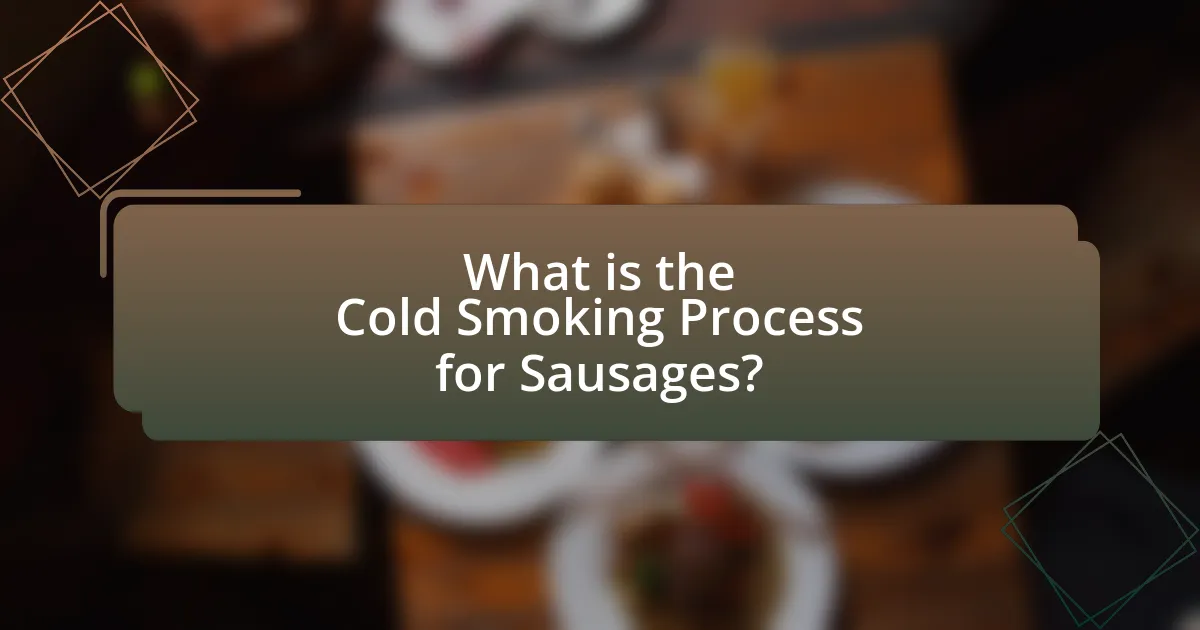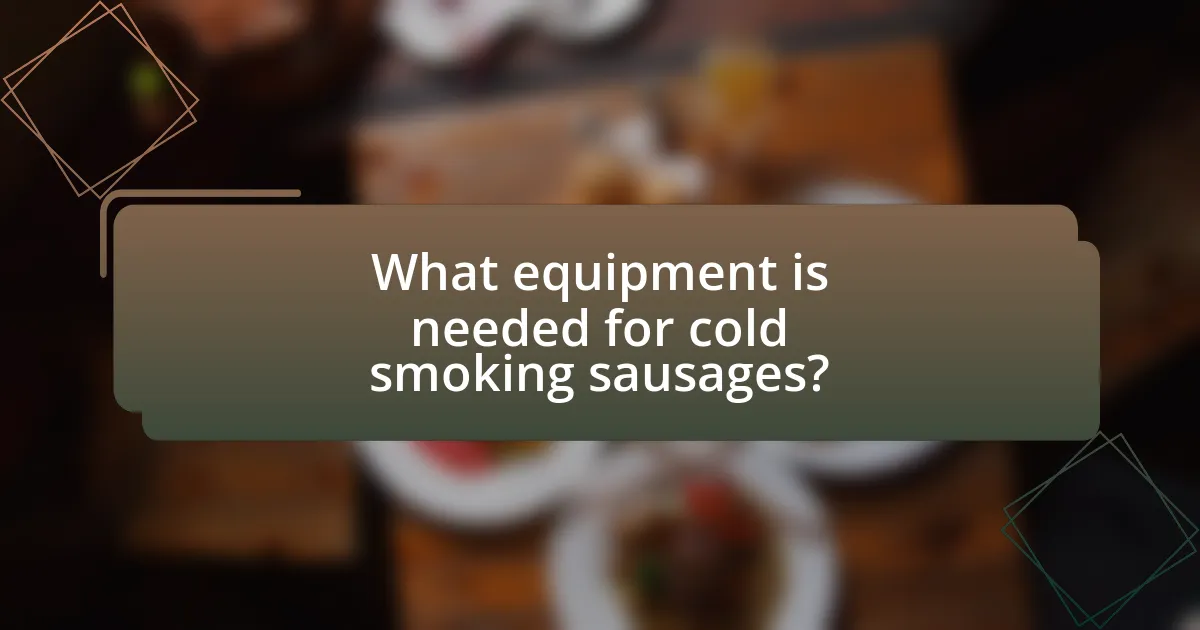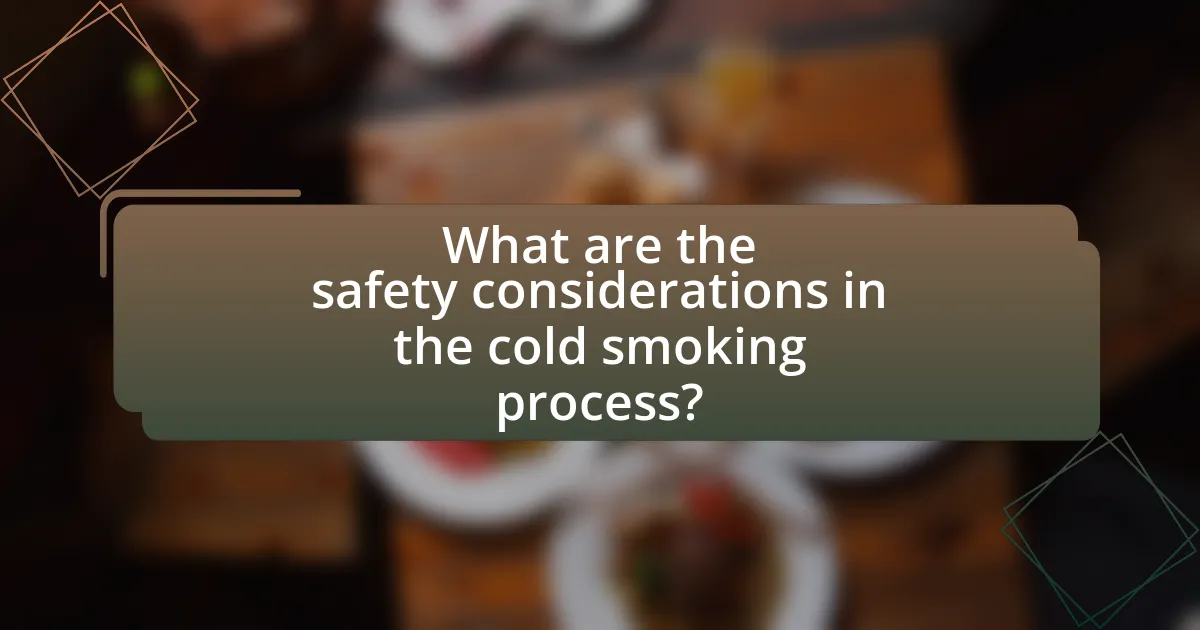The article focuses on the cold smoking process for sausages, which involves exposing sausages to smoke at temperatures below 85°F (29°C) for extended periods to enhance flavor and preserve the meat without cooking it. It distinguishes cold smoking from hot smoking, emphasizing the importance of curing to inhibit bacterial growth. Key stages of the cold smoking process, suitable sausage types, and the impact of different wood types on flavor are discussed, along with best practices for preparation, equipment needed, and safety considerations. The article also addresses common mistakes to avoid and tips for enhancing the cold smoking experience, ensuring a comprehensive understanding of this preservation technique.

What is the Cold Smoking Process for Sausages?
The cold smoking process for sausages involves exposing the sausages to smoke at temperatures typically below 85°F (29°C) for an extended period, usually several hours to days. This method enhances flavor and preserves the meat without cooking it, allowing the sausages to retain their raw texture. Cold smoking is often performed after the sausages have been cured, as the curing process helps inhibit bacterial growth, making it safe to smoke at lower temperatures.
How does cold smoking differ from hot smoking?
Cold smoking differs from hot smoking primarily in temperature and purpose. Cold smoking occurs at temperatures below 90°F (32°C), which imparts flavor and preserves food without cooking it, making it suitable for items like sausages. In contrast, hot smoking takes place at temperatures between 165°F (74°C) and 250°F (121°C), cooking the food while also adding flavor, resulting in a fully cooked product. This distinction is crucial for food safety and texture, as cold smoking requires additional curing methods to prevent bacterial growth, while hot smoking ensures the food is safe to eat immediately after the process.
What temperature range is considered cold smoking?
Cold smoking is typically conducted at temperatures ranging from 68°F to 86°F (20°C to 30°C). This temperature range is essential for preserving the food while imparting smoky flavors without cooking it. Cold smoking is often used for meats, cheeses, and fish, allowing for flavor enhancement while maintaining the texture and moisture of the food.
What are the key stages in the cold smoking process?
The key stages in the cold smoking process include preparation, smoking, and curing. Preparation involves selecting and seasoning the meat, ensuring it is properly trimmed and salted to enhance flavor and preservation. The smoking stage requires maintaining a low temperature, typically below 85°F (29°C), while exposing the meat to smoke for several hours to impart flavor. Finally, the curing stage allows the smoked meat to rest, enabling the flavors to develop and the preservation process to complete, often involving refrigeration or further drying. These stages are essential for achieving the desired taste and safety in cold-smoked sausages.
Why is cold smoking used for sausages?
Cold smoking is used for sausages primarily to enhance flavor and preserve the meat. This method involves exposing sausages to smoke at temperatures below 85°F (29°C), which allows for the infusion of smoky flavors without cooking the meat. The low temperatures help maintain the texture and moisture of the sausages while also inhibiting the growth of spoilage bacteria, thus extending shelf life. Additionally, compounds in the smoke, such as phenols, contribute to antimicrobial properties, further aiding in preservation.
What flavors does cold smoking impart to sausages?
Cold smoking imparts a rich, smoky flavor to sausages, enhancing their overall taste profile. This process involves exposing the sausages to smoke at low temperatures, typically below 85°F, allowing the smoke to penetrate the meat without cooking it. The smoke contains various compounds, such as phenols and carbonyls, which contribute to the distinct flavor and aroma associated with cold-smoked products. Additionally, the type of wood used for smoking, such as hickory, apple, or mesquite, can further influence the flavor, adding unique notes that complement the sausage’s ingredients.
How does cold smoking affect the preservation of sausages?
Cold smoking enhances the preservation of sausages by introducing smoke compounds that inhibit microbial growth and oxidation. The process involves exposing sausages to smoke at temperatures below 30°C (86°F), which allows for flavor infusion while minimizing cooking. Studies indicate that the phenolic compounds in smoke, such as guaiacol and syringol, possess antimicrobial properties that can extend shelf life. Additionally, cold smoking helps to form a protective layer on the sausage surface, further reducing spoilage and rancidity.
What types of sausages are suitable for cold smoking?
Sausages suitable for cold smoking include those with a higher fat content and those that are cured or fermented. Examples are salami, pepperoni, and chorizo, which benefit from the cold smoking process that enhances their flavor without cooking them. Cold smoking is effective for these types because they are typically made with ingredients that can withstand lower temperatures and benefit from the infusion of smoke.
Which ingredients enhance the cold smoking process for specific sausages?
Certain ingredients enhance the cold smoking process for specific sausages, including salt, sugar, and various spices. Salt acts as a preservative and helps to draw moisture out of the meat, which is crucial for effective smoking. Sugar, particularly in the form of brown sugar or honey, not only balances the saltiness but also aids in the caramelization process during smoking, contributing to flavor and color. Spices such as black pepper, garlic powder, and paprika add depth and complexity to the sausage’s flavor profile. These ingredients are commonly used in traditional sausage recipes, where their roles are well-documented in culinary practices, ensuring optimal results in the cold smoking process.
What are the best practices for preparing sausages for cold smoking?
The best practices for preparing sausages for cold smoking include selecting high-quality meat, ensuring proper seasoning, and maintaining appropriate moisture levels. High-quality meat, such as pork or beef, should be freshly ground and mixed with spices, salt, and curing agents to enhance flavor and preservation. Proper seasoning typically involves a balance of salt and spices, which not only adds taste but also aids in the curing process, essential for safety during cold smoking. Maintaining moisture levels is crucial; sausages should be stuffed tightly into casings to prevent air pockets, which can lead to spoilage. Additionally, allowing sausages to rest in a cool environment for several hours or overnight helps develop flavors and ensures even smoking. These practices are supported by food safety guidelines that emphasize the importance of curing and moisture control in preventing bacterial growth during the cold smoking process.

What equipment is needed for cold smoking sausages?
To cold smoke sausages, the essential equipment needed includes a cold smoker or a smoke generator, wood chips or pellets, a temperature control device, and a suitable smoking chamber or grill. A cold smoker or smoke generator allows for the production of smoke without raising the temperature significantly, which is crucial for preserving the sausages’ texture and flavor. Wood chips or pellets provide the necessary smoke flavor, while a temperature control device ensures that the smoking environment remains within the ideal range, typically below 90°F (32°C). A smoking chamber or grill must be capable of maintaining low temperatures while allowing smoke circulation.
How do different cold smoking setups work?
Different cold smoking setups work by utilizing a controlled environment to infuse smoke flavor into food without cooking it. The primary methods include using a dedicated cold smoker, a smoke generator, or a traditional smoker with temperature control.
A dedicated cold smoker operates at temperatures below 90°F (32°C) and often features a separate chamber for the smoke source, allowing for consistent smoke infusion without heat affecting the food. Smoke generators, which can be standalone units or attachments, produce smoke from wood chips or pellets and can be used in conjunction with other smoking devices to maintain low temperatures. Traditional smokers can also be adapted for cold smoking by using ice or water pans to regulate heat, ensuring that the food remains in a safe temperature range while absorbing smoke.
These setups are validated by the fact that cold smoking is commonly used for preserving and flavoring meats, cheeses, and fish, with historical practices dating back centuries, demonstrating their effectiveness in enhancing food preservation and taste.
What are the pros and cons of using a dedicated cold smoker?
Using a dedicated cold smoker offers distinct advantages and disadvantages. The primary benefit is that it allows for precise temperature control, which is essential for cold smoking, ensuring that food does not cook but absorbs smoke flavor effectively. Additionally, dedicated cold smokers often have better airflow and smoke distribution, leading to a more uniform flavor profile in the food. However, the cons include the higher initial investment cost compared to other smoking methods and the requirement for more space, as dedicated cold smokers can be larger and less portable. Furthermore, they may require more maintenance and cleaning due to the build-up of smoke residue.
Can you cold smoke sausages using a regular grill or smoker?
Yes, you can cold smoke sausages using a regular grill or smoker, provided that you can maintain a low temperature below 90°F (32°C) during the smoking process. Cold smoking requires a controlled environment to prevent the sausages from cooking, which can be achieved by using indirect heat or a cold smoke generator. Many regular grills can be adapted for cold smoking by creating a separate smoking chamber or using wood chips in a smoker box, allowing for the infusion of smoke flavor without raising the temperature significantly.
What materials are essential for cold smoking?
The essential materials for cold smoking include a cold smoker or smoke generator, wood chips or pellets, and the food item to be smoked, typically sausages. A cold smoker or smoke generator is necessary to produce smoke without applying heat, which is crucial for maintaining the low temperatures required in cold smoking. Wood chips or pellets, such as hickory, apple, or cherry, provide the flavor and aroma during the smoking process. The food item, often sausages, is the main subject of cold smoking, absorbing the smoke flavor while remaining at a safe temperature to prevent cooking.
What types of wood chips are best for cold smoking sausages?
Hickory, apple, and cherry wood chips are best for cold smoking sausages. Hickory provides a strong, smoky flavor that complements meats well, while apple and cherry offer a milder, sweeter taste that enhances the overall profile of the sausage without overpowering it. These wood types are commonly used in traditional smoking practices, as they impart distinct flavors that are widely appreciated in culinary applications.
How do different wood types influence the flavor of smoked sausages?
Different wood types significantly influence the flavor of smoked sausages by imparting distinct aromatic compounds during the smoking process. For instance, hickory wood provides a strong, bacon-like flavor, while applewood offers a milder, sweeter taste that complements the meat without overpowering it. Mesquite wood delivers a robust, earthy flavor, often associated with Texas-style barbecue, which can enhance the richness of the sausage.
Research indicates that the chemical composition of the smoke produced by various woods, including phenols and carbonyls, contributes to these flavor profiles. A study published in the Journal of Food Science by authors including K. A. Kauffman and J. A. C. H. van der Linde highlights how different wood species release unique volatile compounds that interact with the meat, affecting both aroma and taste. Thus, the choice of wood type is crucial for achieving the desired flavor in smoked sausages.

What are the safety considerations in the cold smoking process?
The safety considerations in the cold smoking process include controlling temperature, ensuring proper ventilation, and monitoring humidity levels. Cold smoking typically occurs at temperatures below 85°F (29°C), which can allow harmful bacteria, such as Listeria and Salmonella, to thrive if not managed properly. Adequate ventilation is essential to prevent the buildup of harmful gases and to ensure even smoke distribution. Additionally, maintaining humidity levels between 60% and 80% helps prevent spoilage and supports the curing process. These factors are critical to ensuring food safety and preventing foodborne illnesses during the cold smoking of sausages.
How can you prevent foodborne illnesses when cold smoking?
To prevent foodborne illnesses when cold smoking, it is essential to maintain proper temperature control and ensure food safety practices. Cold smoking should occur at temperatures below 40°F (4°C) to inhibit bacterial growth, and the food should be cured with salt or a curing agent to reduce pathogens. Additionally, using high-quality, fresh ingredients and ensuring that all equipment is sanitized can further minimize risks. Research indicates that proper curing and temperature management significantly lower the incidence of foodborne pathogens in smoked products, supporting the effectiveness of these preventive measures.
What are the recommended internal temperatures for safe sausage smoking?
The recommended internal temperature for safe sausage smoking is 160°F (71°C) for pork and beef sausages, and 165°F (74°C) for poultry sausages. These temperatures ensure that harmful bacteria are effectively killed during the smoking process. The USDA guidelines specify these temperatures to guarantee food safety, as they are critical for preventing foodborne illnesses associated with undercooked meats.
How does humidity affect the safety of cold smoking?
Humidity significantly affects the safety of cold smoking by influencing the growth of harmful bacteria. High humidity levels can create an environment conducive to bacterial proliferation, particularly pathogens like Listeria and Salmonella, which thrive in moist conditions. Research indicates that maintaining humidity levels between 60% and 80% during cold smoking can enhance flavor but also increases the risk of spoilage and foodborne illness if not monitored carefully. Therefore, controlling humidity is crucial to ensure that the cold smoking process remains safe and effective for preserving sausages.
What are common mistakes to avoid in cold smoking sausages?
Common mistakes to avoid in cold smoking sausages include not properly curing the meat, failing to maintain the correct temperature, and using inappropriate wood for smoking. Proper curing is essential to prevent bacterial growth; for instance, using a curing salt with sodium nitrite can inhibit pathogens. Maintaining a temperature below 85°F (29°C) is crucial to ensure the meat does not cook during the smoking process, which can lead to undesirable textures and flavors. Additionally, using hardwoods like hickory or applewood is recommended, as softwoods can impart resinous flavors that negatively affect the sausage.
How can improper smoking times affect sausage quality?
Improper smoking times can significantly degrade sausage quality by affecting flavor, texture, and safety. When sausages are smoked for too short a duration, they may lack the desired smoky flavor and fail to develop a proper outer crust, resulting in a less appealing texture. Conversely, excessive smoking can lead to an overpowering taste and a dry, tough texture due to moisture loss. Additionally, inadequate smoking times may not effectively kill harmful bacteria, compromising food safety. Research indicates that optimal smoking times are crucial for achieving the right balance of flavor and safety, as demonstrated in studies on meat preservation techniques.
What are the signs of over-smoking or under-smoking sausages?
The signs of over-smoking sausages include a bitter or acrid taste, excessive dark coloration on the surface, and a dry, tough texture. These indicators suggest that the sausages have absorbed too much smoke, leading to an unpleasant flavor profile and compromised mouthfeel.
Conversely, under-smoking sausages is characterized by a lack of smoky flavor, pale coloration, and a moist texture that may feel undercooked. This indicates insufficient exposure to smoke, resulting in a bland taste and an unappealing appearance.
Both over-smoking and under-smoking can significantly affect the overall quality of the sausages, making it essential to monitor the smoking process closely.
What tips can enhance the cold smoking experience for sausages?
To enhance the cold smoking experience for sausages, ensure proper temperature control, maintain humidity levels, and select the right wood for smoking. Maintaining a temperature below 80°F (27°C) is crucial to prevent cooking the sausages while allowing smoke to infuse flavor. Humidity should be kept around 60-70% to prevent the sausages from drying out too quickly, which can lead to uneven smoking. Additionally, using hardwoods like hickory, apple, or cherry provides distinct flavors that complement the meat, as these woods are known for their aromatic properties.
How can you experiment with flavors during the cold smoking process?
To experiment with flavors during the cold smoking process, one can incorporate various wood types, herbs, and spices into the smoking setup. Different wood types, such as hickory, apple, or cherry, impart distinct flavors to the sausages, while adding herbs like rosemary or thyme directly onto the smoking chips can enhance the aroma and taste. Additionally, marinating the sausages in flavored brines or rubs before smoking can further infuse them with unique flavors. This method is supported by culinary practices that emphasize the importance of wood selection and seasoning in flavor development during smoking.
What are the best practices for storing cold smoked sausages?
The best practices for storing cold smoked sausages include keeping them in a cool, dry place, ideally in a refrigerator or a controlled environment with temperatures between 32°F and 40°F (0°C to 4°C). Properly wrapping the sausages in butcher paper or vacuum-sealing them helps to maintain their quality and prevent moisture loss. Additionally, storing them away from strong odors and direct sunlight preserves their flavor and texture. Cold smoked sausages can last several weeks when stored correctly, as the smoking process inhibits bacterial growth, but it is essential to monitor for any signs of spoilage.
